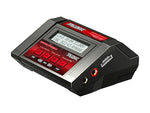A Complete Guide To FPV Batteries: Powering Your Flight Experience
First-person view (FPV) drones have revolutionized the world of aerial photography, racing, and exploration. Central to the performance and longevity of these drones is the battery. Understanding the intricacies of FPV batteries is crucial for anyone looking to optimize their drone’s flight time, performance, and overall experience.
This
blog delves into the types, specifications, maintenance, and best practices for
using FPV
batteries.
FPV
drones primarily use Lithium Polymer (LiPo) batteries due to their high energy
density and discharge rates. LiPo batteries come in various configurations and
specifications, making it essential to choose the right one for your specific
drone and flying style.
Voltage
(Cell Count)
FPV
batteries are categorized by
their cell count, denoted as "S." Each cell provides a
nominal voltage of 3.7V, with a fully charged voltage of 4.2V. Common
configurations include 1S (3.7V), 2S (7.4V), 3S (11.1V), 4S (14.8V), and 6S
(22.2V).
Higher
cell counts provide more power, making 4S and 6S batteries popular for
high-performance racing and freestyle drones.
Capacity
(mAh)
Measured
in milliampere-hours (mAh), capacity indicates the total energy the battery can
store. Higher capacity batteries provide longer flight times but are also
heavier, affecting the drone's agility and performance. Selecting the
right balance between capacity and weight is key to optimizing flight
time without compromising on maneuverability.
Discharge
Rate (C Rating)
The
discharge rate, or C rating, determines how quickly the battery can release its
stored energy. A higher C rating means the battery can deliver more power,
which is crucial for high-speed maneuvers and avoiding voltage sag during
demanding flights. However, consistently using batteries at their maximum C
rating can reduce their lifespan.
Choosing
the Right FPV Battery
When choosing an
FPV battery, consider the following factors:
Drone
Type: Lightweight drones used for racing
might benefit from high C rating, lower capacity batteries, while
larger, more stable drones for aerial photography might require higher
capacity batteries for extended flight times.
Flight
Style: Aggressive flying and
racing demand batteries with high C ratings to ensure consistent
power delivery. For cruising or gentle flying, batteries with lower C
ratings may suffice.
Weight: Heavier
batteries increase flight time but reduce agility. Balance is key,
especially for racing drones where every gram counts.
Maintaining
FPV Batteries
Proper
maintenance extends the life of your FPV batteries and ensures
safety:
Storage: Store
LiPo batteries at around 3.8V per cell, typically 50-60% charge.
Use a LiPo storage bag for added safety.
Charging: Use
a balanced charger to ensure each cell is charged equally. Avoid overcharging
and always monitor batteries during charging.
Usage: Avoid
fully discharging your batteries. Aim to land your drone when the battery
reaches 20-30% capacity to prolong its life.
Inspection:
Regularly check for physical damage,
puffing, or irregularities. Damaged batteries should be disposed of properly.
Briefly
Put!
FPV
batteries are the powerhouse
behind every thrilling drone flight. By understanding their specifications,
selecting the right battery for your needs, you can enhance your flying
experience while ensuring safety and longevity. Whether you're a
seasoned racer or a casual flyer, investing time in learning about FPV
batteries will pay off in better performance and more enjoyable flights.


Comments
Post a Comment